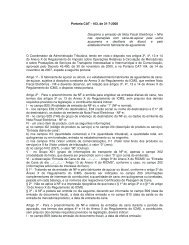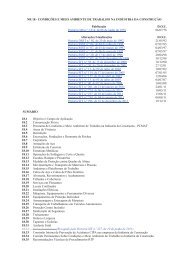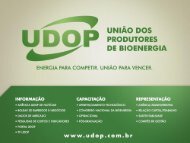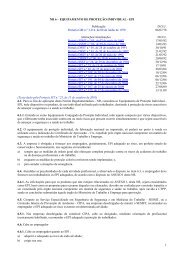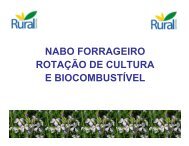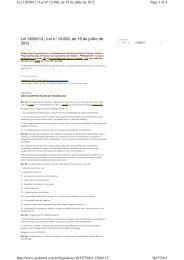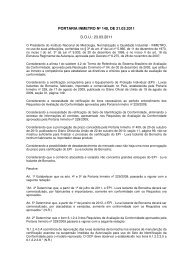- Page 2 and 3:
B615b Bioetanol de cana-de-açúcar
- Page 4 and 5:
Bioetanol-00.indd 4 11/11/2008 15:2
- Page 6:
7.3 Viabilidade econômica do bioet
- Page 9 and 10:
24 Consumo de fertilizantes pelas p
- Page 11 and 12:
Bioetanol-00.indd 11 11/11/2008 15:
- Page 13 and 14:
H HH C C O HH HPrefácioPetróleo,
- Page 15 and 16:
Bioetanol-00.indd 15 11/11/2008 15:
- Page 17 and 18:
H HH C C O HH HC 2H 5OHApresentaç
- Page 19 and 20:
Nessa direção, é importante cons
- Page 21 and 22:
Luz do solque a folha traga e tradu
- Page 23 and 24:
Capítulo 1Bioenergia e biocombust
- Page 25 and 26:
1.1 Fundamentos da bioenergiaEm sua
- Page 27 and 28:
A produção de biomassa, como resu
- Page 29 and 30:
Além dos fatores básicos (luz, á
- Page 31 and 32:
Da radiação solar incidente sobre
- Page 33 and 34:
Do Brasil colonial, temos o registr
- Page 35 and 36:
Desse modo, os sistemas bioenergét
- Page 37 and 38:
Bioetanol-01.indd 37 11/11/2008 15:
- Page 39 and 40:
Capítulo 2Etanol como combustível
- Page 41 and 42:
2.1 Dimensões técnicas e ambienta
- Page 43 and 44:
Canadá e na Suécia, também são
- Page 45 and 46:
totalmente o chumbo tetraetila e so
- Page 47 and 48:
Separação de fasesA possibilidade
- Page 49 and 50:
Tabela 5 - Durabilidade de materiai
- Page 51 and 52:
centelha o fazem pouco atrativo par
- Page 53 and 54:
O etanol em motores aeronáuticosAv
- Page 55 and 56:
ços superiores a tal preço. Natur
- Page 57 and 58:
utilizar preferencialmente sua mat
- Page 59 and 60:
de bioetanol à gasolina, a ser imp
- Page 61 and 62:
consumo para atender à demanda de
- Page 63 and 64:
produção segue por rotas mais dir
- Page 65 and 66:
Bioetanol-02.indd 65 11/11/2008 15:
- Page 67 and 68:
Capítulo 3Produção de bioetanolD
- Page 69 and 70:
3.1 Matérias-primas e tecnologias
- Page 71 and 72:
Gráfico 8 - Produtividade média d
- Page 73 and 74:
Gráfico 10 - Principais países pr
- Page 75 and 76:
típicas no Centro-Sul brasileiro (
- Page 77 and 78:
Figura 9 - Distribuição das 350 u
- Page 79 and 80:
Figura 10 - Diagrama de fluxo da pr
- Page 81 and 82:
ebulição inferior ao do bioetanol
- Page 83 and 84:
(processos sucessivos de cristaliza
- Page 85 and 86:
Figura 12 - Distribuição da produ
- Page 87 and 88:
(alfa-amilase), a fim de promover a
- Page 89 and 90:
lação. A vinhaça produzida nessa
- Page 91 and 92:
(melaço) sempre disponível na pro
- Page 93 and 94:
das energias envolvidas no processo
- Page 95 and 96:
mas de co-geração de 9 MJ/kWh e 7
- Page 97 and 98:
Figura 16 - Análise de sensibilida
- Page 99 and 100:
Atualmente, a produção do bioetan
- Page 101 and 102:
Tabela 16 - Comparação das difere
- Page 103 and 104:
Capítulo 4Co-produtos do bioetanol
- Page 105 and 106:
4.1 Açúcar e derivadosComponente
- Page 107 and 108:
As possibilidades do açúcar orgâ
- Page 109 and 110:
No processamento industrial da cana
- Page 111 and 112:
Com a valorização mais recente de
- Page 113 and 114:
Assumindo a operação de uma usina
- Page 115 and 116:
Evolução da produção de eletric
- Page 117 and 118:
No caso brasileiro, a responsabilid
- Page 119 and 120:
Vitória de Santo Antão, em Pernam
- Page 121 and 122:
É oportuno observar as maneiras pe
- Page 123 and 124:
Capítulo 5Tecnologias avançadas n
- Page 125 and 126:
5.1 Hidrólise de resíduos lignoce
- Page 127 and 128:
Tabela 20 - Processos para pré-tra
- Page 129 and 130:
trado apresenta rendimentos maiores
- Page 131 and 132:
Organosolv combinado com a hidróli
- Page 133 and 134:
5.2 Gaseificação para produção
- Page 135 and 136:
zado em um ciclo a vapor para a ger
- Page 137 and 138:
pelo então Centro de Tecnologia da
- Page 139 and 140:
Tabela 24 - Comparação dos rendim
- Page 141 and 142:
Tabela 25 - Processos básicos da i
- Page 143 and 144:
5.4 Produção de plásticos biodeg
- Page 145 and 146:
pelo fornecimento do açúcar utili
- Page 147 and 148:
dade) com base em diferentes biomas
- Page 149 and 150:
Bioetanol-05.indd 149 11/11/2008 15
- Page 151 and 152:
Capítulo 6Bioetanol de cana-de-aç
- Page 153 and 154:
6.1 Evolução do bioetanol combust
- Page 155 and 156:
firmado pelo presidente Geisel. Ess
- Page 157 and 158:
liberalização e rearranjo institu
- Page 159 and 160:
na gasolina, apresentada desde o in
- Page 161 and 162:
Nos Gráficos 16, 17 e 18, é poss
- Page 163 and 164:
Gráfico 20 - Distribuição da cap
- Page 165 and 166:
Figura 24 - Localização das novas
- Page 167 and 168:
mando-se que correspondam a 12% da
- Page 169 and 170:
de petróleo com 35 mil barris diá
- Page 171 and 172:
cadeia dos biocombustíveis, com ê
- Page 173 and 174:
Entre as instituições federais si
- Page 175 and 176:
com base em resíduos celulósicos,
- Page 177 and 178:
Bioetanol-06.indd 177 11/11/2008 15
- Page 179 and 180:
Capítulo 7Sustentabilidade do bioe
- Page 181 and 182:
7.1 Ambiente e energia da cana-de-a
- Page 183 and 184:
Resultados similares, que respaldam
- Page 185 and 186:
e condensadores de álcool. Com a r
- Page 187 and 188:
Como uma indicação importante da
- Page 189 and 190:
promove uma supressão na germinaç
- Page 191 and 192:
Em síntese, o uso de fertilizantes
- Page 193 and 194:
Figura 26 - Exemplo de imagem de sa
- Page 195 and 196:
dos crescentes esforços governamen
- Page 197 and 198:
Gráfico 27 - Uso da terra nas prop
- Page 199 and 200:
Zoneamento agroecológicoVisando or
- Page 201 and 202:
No mapa de potencial de plantio de
- Page 203 and 204:
Tabela 32 - Demanda de áreas para
- Page 205 and 206:
Nas condições brasileiras, a matr
- Page 207 and 208:
com diferentes produtividades e tec
- Page 209 and 210:
Dessa maneira, considerados todos o
- Page 211 and 212:
de safra e entressafra. Para uma un
- Page 213 and 214:
visando ao pagamento correto dos co
- Page 215 and 216:
No entanto, para preservar a agricu
- Page 217 and 218:
assegurar que os biocombustíveis s
- Page 219 and 220:
−Os governos do Brasil, dos Estad
- Page 221 and 222:
Capítulo 8Perspectivas para um mer
- Page 223 and 224:
8.1 Potencial global para produçã
- Page 225 and 226:
o sebo e outros subprodutos gorduro
- Page 227 and 228:
Os resultados desse estudo são bas
- Page 229 and 230:
Em relação ao uso da terra e seu
- Page 231 and 232:
nol mais do que duplicou desde 2000
- Page 233 and 234:
países asiáticos alcançou 7,4 bi
- Page 235 and 236:
América do Norte, exclusive Méxic
- Page 237 and 238:
Com o objetivo de criar mercados ma
- Page 239 and 240:
iocombustíveis [UPME (2006)]. Esse
- Page 241 and 242:
Guatemala, Guiana, Haiti, Honduras,
- Page 243 and 244:
No contexto do CBI, na maioria dos
- Page 245 and 246:
poderá ser recolocado em operaçã
- Page 247 and 248:
Os derivados de petróleo são fort
- Page 249 and 250:
Para concluir a revisão prospectiv
- Page 251 and 252:
e biodiesel. As políticas referent
- Page 253 and 254: A segurança alimentar e a produç
- Page 255 and 256: contudo, ao crescimento de cerca de
- Page 257 and 258: enda das famílias. Mas, por outro
- Page 259 and 260: iii) estimativa dos “potenciais e
- Page 261 and 262: as matérias-primas relacionadas ao
- Page 263 and 264: Gráfico 43 - Índices de preço pa
- Page 265 and 266: turfosas e outros depósitos de car
- Page 267 and 268: As questões-chave para a promoçã
- Page 269 and 270: Bioetanol-08.indd 269 11/11/2008 15
- Page 271 and 272: Capítulo 9Uma visão de futuro par
- Page 273 and 274: A sociedade moderna tem enfrentado
- Page 275 and 276: 345678O bioetanol de cana-de-açúc
- Page 277 and 278: para serem alcançados a médio pra
- Page 279 and 280: que, por sua demanda de combustíve
- Page 281 and 282: AnexosBioetanol-Anexo.indd 281 11/1
- Page 283 and 284: Anexo 1 - Produção de cana e etan
- Page 285 and 286: Anexo 3 - Preço do etanol pago ao
- Page 287 and 288: ReferênciasBioetanol-Referencias.i
- Page 289 and 290: ABIOVE. Estatísticas do Complexo d
- Page 291 and 292: BERNDES, G. et al. “The contribut
- Page 293 and 294: CETESB - COMPANHIA DE TECNOLOGIA DE
- Page 295 and 296: ______. “Erosão na cultura da ca
- Page 297 and 298: ______. Sugar: global market analys
- Page 299 and 300: GOLDEMBERG, J. et al. “The Brazil
- Page 301 and 302: ICRISAT - INTERNATIONAL CROPS RESEA
- Page 303: JORNAL DO COMMERCIO. “Coperbo: um
- Page 307 and 308: NCGA - NATIONAL CORN GROWERS ASSOCI
- Page 309 and 310: REFUEL. Eyes on the track, mind on
- Page 311 and 312: SMA - SECRETARIA DE MEIO AMBIENTE D
- Page 313 and 314: UNEP - UNITED NATIONS ENVIRONMENTAL
- Page 315 and 316: Coordenação EditorialGerência de




